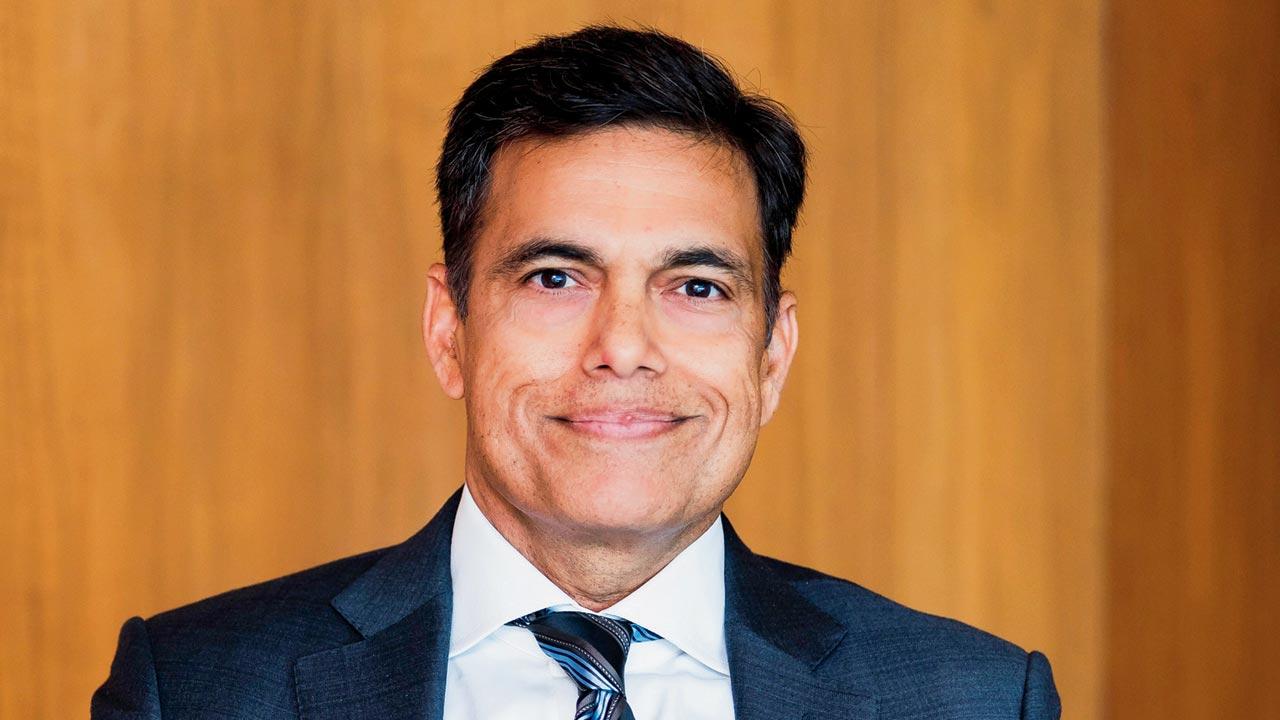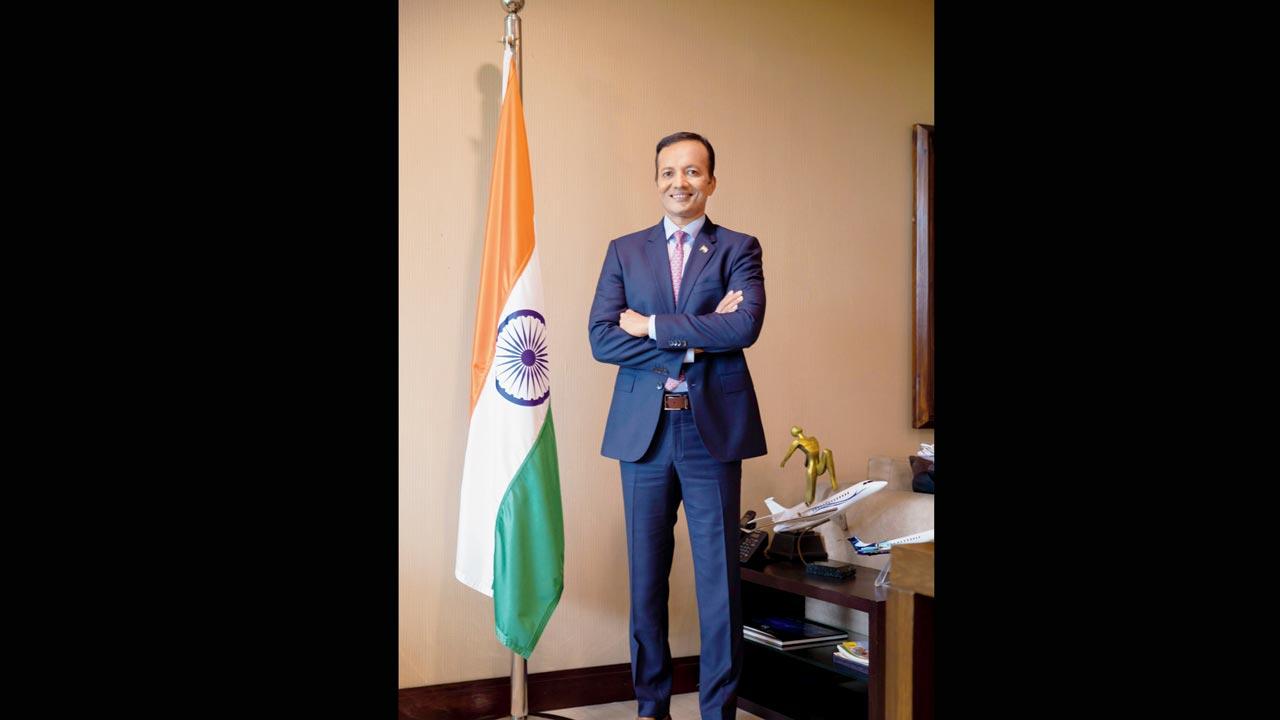While PM Modi’s new campaign hopes to have every Indian fly the national flag this weekend, a business family that has been displaying the Tiranga daily for the last 18 years, tells us what it takes to keep it flying high

A staff of Jindal Mansion seen adjusting the Tiranga, which is hoisted from the third floor of the premises. Pics/Ashish Raje
At the white-washed Jindal Mansion at Pedder Road, the Tiranga shines like a superstar, especially on the rare occasion where Indian patriotism is being celebrated. Like last year in July, when weightlifter Saikhom Mirabai Chanu won the silver at the Tokyo Summer Olympics. Tomorrow, when Independent India turns 75, a similar spectacle will be on display. And at the centre of it all, will be the iconic India flag, hoisted from the third floor of the mansion, flying high since 2004.
The Jindals, in a way, have been frontrunners in instilling patriotic fervour. Long before, Prime Minister Narendra Modi launched the Har Ghar Tiranga campaign under the Azadi Ka Amrit Mahotsav, encouraging every household to hoist the flag, industrialist and former Parliamentarian Naveen Jindal had set the wheels in motion to bring the Tiranga home.
Naveen won a decade-long legal battle when the Supreme Court of India delivered the historic judgement on January 23, 2004, three days before Republic Day, enabling all Indians to display the National Flag with “respect, dignity and honour”. “Soon after the judgement—in fact the very same year—my elder brother Sajjan Jindal and bhabhi Sangita Jindal took the initiative to hoist the flag at Jindal Mansion,” says Naveen, whose concerted efforts also led the home ministry in 2009, to allow Indians to fly the flag in the night, provided the “flagpole is really tall and the flag itself well-illuminated”.

Today, the India flag has a pride of place at the mansion, which houses several offices of the Jindals; the JSW Centre in BKC, as well as the three offices of Jindal Steel and Power Limited in Delhi-NCR.
But both Sajjan and Naveen admit that hoisting the Tiranga comes with great responsibility.
Naveen’s own motivation to make the flag accessible to all began in 1990, when he was a student in the United States of America. “I was studying at The University of Texas in Dallas, and I remember all the students displaying the American flag... I wanted to do the same as an Indian,” recalls Naveen over a video call. A few days later, an American friend gifted him a large Indian flag, and he says, “it was the first time, I ever held the national flag in my hand... and that too, in America. I cannot even begin to express how happy that made me”. Later, as president of the Student Government, he was given an office, where he was allowed to display the India flag. “After I returned to India, I remember this one time on January 26, 1993, when we decided to hoist the flags at our steel plants in Chhattisgarh [then part of Madhya Pradesh]. The following day, it was brought down, and I was told that the protocol meant that I could only fly the flag on Republic Day and August 15. That to me was strange. I decided to continue to display the flag,” says Naveen, who is currently chairman of Jindal Steel and Power Limited. “But a year-and-a-half later, when senior police officials happened to visit one of the sites, they immediately asked it to be removed,” he shares, adding that it’s what compelled him to eventually knock the doors of the court in 1994.
 Sajjan Jindal
Sajjan Jindal
Close on heels of the SC’s judgement, Naveen, along with wife Shallu Jindal, started the Flag Foundation of India (FFOI), a non-profit body, with a vision to popularise the display of the Tiranga by every Indian. It has helped setup nearly 100 monumental flags across India, maintaining the upkeep of around 15 to 20 of them, including the one installed at Central Park, Connaught Place, New Delhi, shares Naveen, president of the foundation.
Maj Gen Ashim Kohli, CEO of the FFOI, who is tasked with the responsibility of ensuring the upkeep of “monumental flags”—a tall flag that is visible by a larger population of people—says everything depends on where a flag is located. “If the flag is hoisted in an area, where there are high winds, there is a chance of it tearing. And that means you have to change the flag very frequently. Bringing the flag down or pulling it up also requires a lot of strength, and that’s usually because of the wind. Which is why, we use a high power motor... its horse power depends on the height and the weight of the flag,” he explains. Another thing to keep in mind is that the flag should be placed at a location that is well lighted, “so that in case of any damage or tear, the team learns of it at the earliest, because you can’t be flying a damaged flag,” he says.
 Naveen Jindal’s unrelenting legal and political campaign led to a revision of the Flag Code of India, which now grants every private citizen the right to fly the Indian National Flag
Naveen Jindal’s unrelenting legal and political campaign led to a revision of the Flag Code of India, which now grants every private citizen the right to fly the Indian National Flag
The size of the National Flag hoisted at the Jindal Mansion is 7 x 6 feet. Hoisted from the third floor of the premises, it rises 11 feet. The one at JSW Centre is 30 x 20 feet, and rises 105 feet from the ground level. Both the flags are made of knitted silk-polyester fabric.
At any given point, a team of five people is dedicated towards the upkeep of the national flags, in compliance with the Flag Code of India. Every three months, these flags are changed.
Sajjan, chairman of JSW Group, who credits his brother Naveen, for his efforts to make the flying of Tiranga possible, told mid-day in an email interview that the JSW Group “has been hoisting the flag at all JSW Group offices, factories, and commercial establishments ever since the Flag Code was amended [in 2004]”. “Previously, the national flag at Jindal Mansion would be hoisted every morning and pulled down at day’s end. In 2016-17, we installed a slanting style flag at Jindal Mansion. This is hoisted 24 hours a day with sufficient illumination during the night. We follow the Flag Code in maintaining the national flags hoisted across our offices and factories.” Sajjan feels that hoisting the flag “imbibes national pride and evokes deep patriotic sentiments” within all his employees and visitors. “Personally, I feel deep pride to see the national flag flying. [It] represents the hopes and aspirations of the people of lndia... and our goal to be a significant partner in building a stronger nation.”
7x6
Size of the India flag in feet hoisted at Peddar Road located Jindal Mansion
 Subscribe today by clicking the link and stay updated with the latest news!" Click here!
Subscribe today by clicking the link and stay updated with the latest news!" Click here!










